香蕉案
- 格式:ppt
- 大小:170.00 KB
- 文档页数:42
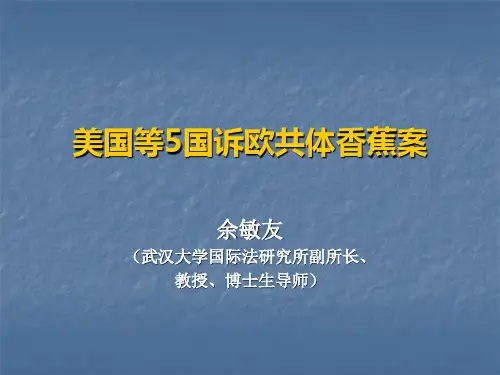
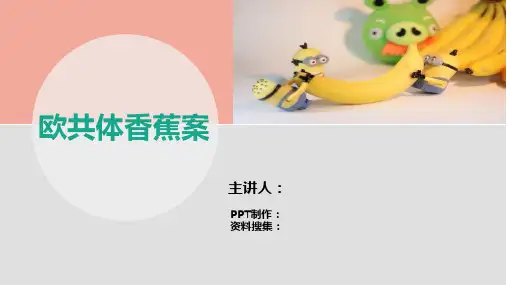
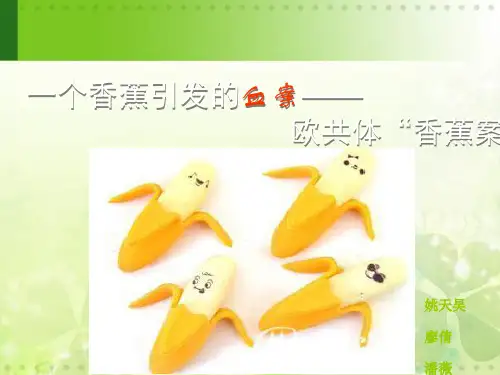
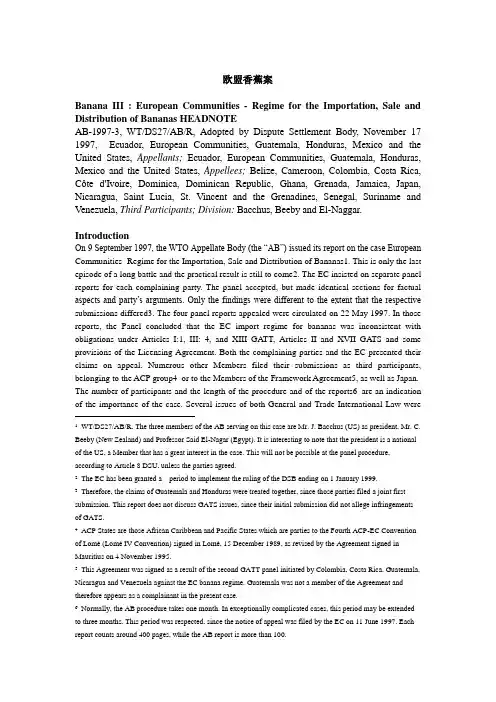
欧盟香蕉案Banana III : European Communities - Regime for the Importation, Sale and Distribution of Bananas HEADNOTEAB-1997-3, WT/DS27/AB/R, Adopted by Dispute Settlement Body, November 17 1997, Ecuador, European Communities, Guatemala, Honduras, Mexico and the United States, Appellants; Ecuador, European Communities, Guatemala, Honduras, Mexico and the United States, Appellees; Belize, Cameroon, Colombia, Costa Rica, Côte d'Ivoire, Dominica, Dominican Republic, Ghana, Grenada, Jamaica, Japan, Nicaragua, Saint Lucia, St. Vincent and the Grenadines, Senegal, Suriname and V enezuela, Third Participants; Division: Bacchus, Beeby and El-Naggar. IntroductionOn 9 September 1997, the WTO Appellate Body (the “AB”) issued its report on the case European Communities- Regime for the Importation, Sale and Distribution of Bananas1. This is only the last episode of a long battle and the practical result is still to come2. The EC insisted on separate panel reports for each complaining party. The panel accepted, but made identical sections for factual aspects and party’s arguments. Only the findings were different to the extent that the respective submissions differed3. The four panel reports appealed were circulated on 22 May 1997. In those reports, the Panel concluded that the EC import regime for bananas was inconsistent with obligations under Articles I:1, III: 4, and XIII GATT, Articles II and XVII GATS and some provisions of the Licensing Agreement. Both the complaining parties and the EC presented their claims on appeal. Numerous other Members filed their submissions as third participants, belonging to the ACP group4 or to the Members of the Framework Agreement5, as well as Japan. The number of participants and the length of the procedure and of the reports6 are an indication of the importance of the case. Several issues of both General and Trade International Law were1WT/DS27/AB/R. The three members of the AB serving on this case are Mr. J. Bacchus (US) as president, Mr. C. Beeby (New Zealand) and Professor Said El-Nagar (Egypt). It is interesting to note that the president is a national of the US, a Member that has a great interest in the case. This will not be possible at the panel procedure, according to Article 8 DSU, unless the parties agreed.2The EC has been granted a period to implement the ruling of the DSB ending on 1 January 1999.3Therefore, the claims of Guatemala and Honduras were treated together, since those parties filed a joint first submission. This report does not discuss GATS issues, since their initial submission did not allege infringementsof GATS.4ACP States are those African Caribbean and Pacific States which are parties to the Fourth ACP-EC Convention of Lomé (Lomé IV Convention) signed in Lomé, 15 December 1989, as revised by the Agreement signed in Mauritius on 4 November 1995.5This Agreement was signed as a result of the second GATT panel initiated by Colombia, Costa Rica, Guatemala, Nicaragua and Venezuela against the EC banana regime. Guatemala was not a member of the Agreement and therefore appears as a complainant in the present case.6Normally, the AB procedure takes one month. In exceptionally complicated cases, this period may be extended to three months. This period was respected, since the notice of appeal was filed by the EC on 11 June 1997. Each report counts around 400 pages, while the AB report is more than 100.examined and given innovative solutions. The AB is building on the WTO provisions to play its institutional role. The rulings of this initial period furnish the fundamental orientation and principles for the future functioning of the dispute settlement of the Organisation. The analysis is therefore separated in two parts, one relating to the issues of importance for International Law and the second one dealing with International Trade rules.ConclusionsAs a result of the AB it has been confirmed that main aspects of the EC import regime for bananas is inconsistent with WTO rules. The EC will be faced with the obligation of implementing the AB Report, while complying with its commitments under the LoméConvention, namely, giving traditional imports of ACP bananas treatment not less favourable than in the past. This ruling will also encourage the EC to negotiate the next Lomé Convention in a manner which will conform with WTO obligations, according to the different possibilities foreseen by the European Commission in its Green Paper7.The EC regime as it stands today is inconsistent with non-discrimination obligations both under GA TT and under GATS, since it favours imports coming from some regions (EC, DOM and ACP countries and those parties to the Framework Agreement on Bananas) to the expense of other exporting countries. The Commission has proposed the following modifications: To maintain the present tariff quota for non-traditional ACP and third country bananas at 2.2 million tonnes at a duty of 75 ECU/tonne (in stead of 100 ECU/tonne). Additionally, a supplementary quota of 353.000 tonnes at a duty of 300 ECU/tonne would be established to take account of the enlargement.The current licensing system would be dismantled by abolishing Category B licenses and export certificates for FAB countries. This will alter the market conditions. The existing licences are designed to allow cross-subsidies between }mporters of dollar bananas and those of traditional ACP and EC bananas, which are less efficient. To compensate the foreseeable income loss for ACP bananas, the Commission proposes a system of technical and financial assistance, defined for each ACP country8. Another effect is to abolish the FAB modifications to the EC Regime. As before those modifications, all Latin American bananas will be treated in the same way, with the difference that they will not be disadvantaged with respect to ACP bananas. Some of the features of the current system, which do not conflict with WTO obligations, such as the existence of tariff quotas, will be maintained.The overall impact of the reform should benefit the European consumers. Dollar bananas will be available at a lower price and this will influence their choices. ACP bananas will still be accessible, since the quota for traditional imports will probably be maintained, at least until the next Loménegotiation. EC bananas will also maintain their quota.Concerning the operators in the European market, those who are benefiting of Category B licenses are going to loose their quota rent. Since most of them are European based companies, the European operators are the most harmed by this AB ruling. On the contrary, those operators traditionally importing dollar bananas, mainly big transnational companies, will benefit from an7Green Paper on relations between the European Union and the ACP countries on the eve of the 21st century, European Commission, 1997. (http://europa.eu.int)8The use of a system of production subsidies had already been pointed out by the doctrine to minimise the distortionary impact of the internal banana market. See READ R. “The EC Banana Market: The Issues and the Dilemma”, The World Economy, 2(1994), 219-235, at 234.additional income due to the lower import tariff.It remains to be seen whether the producers in the developing countries of the tropical areas will really gain from the reform to be undertaken or if the profit will stay in the trading companies.It is widely acknowledged that the current WTO dispute settlement has moved towards a more rule-oriented system9. The Report in this case contains several innovative conclusions which have a meaning in the definition of the institutional role of the AB. The possibility for private lawyers to represent a Member’s delegation in the AB hearing represents some openness of a purely intergovernmental system. Private lawyers may give a more legally oriented reasoning than government officials. Furthermore, the way in which the AB modifies the reasoning of the Panel in certain points such as the interpretation of the Japan-Alcoholic Beverages case10 reveals a concern for clarity of the legal reasoning, towards a more predictable system. The call for a system of preliminary rulings goes certainly in the same direction. Their impact would depend much on whether they would be admitted as authoritative interpretation or not11.The AB is building up its own identity. As a young institution, it has to provide in its early rulings with principles and guidance that will probably be followed in the future. As in other Reports12, the AB is contributing to the consolidation of the rule of law in the field of international trade.9See YOUNG, M. “Dispute resolution in the Uruguay Round: Lawyers triumph over diplomats”, The International Lawyer, 2(1995) 29 389-409 and MONTAÑÀ I MORA, “A GATT with teeth: Law wins over politics in the resolution of international trade disputes”, 31 Columbia Journal of Transnational Law, 103 (1993), 128-136.10See supra note 错误!未定义书签。

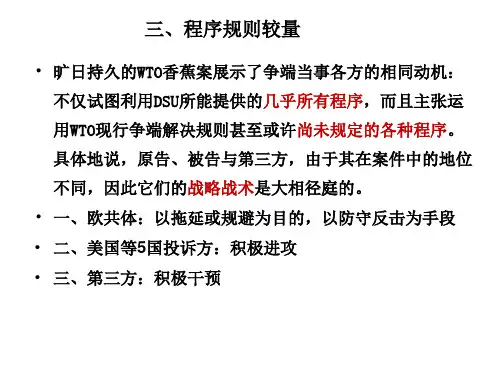
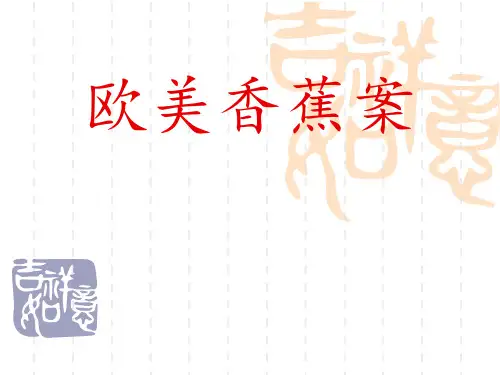

WTO公布厄瓜多尔再诉欧盟香蕉案执行情况专家组报告(2008-04-13 21:10:06)转载分类:WTO争端解决欧盟香蕉案再次败诉——WTO执行专家组裁定欧盟没有执行争端解决机构香蕉案裁决2008年4月7日,WTO公布“欧共体——香蕉进口、销售和分销体制案”(厄瓜多尔第二次诉诸DSU第21.5条)执行专家组报告,裁定欧盟没有执行争端解决机构作出的建议和裁决。
2006年11月16日,厄瓜多尔再次根据《关于争端解决程序与规则的谅解》(DSU)第21.5条和GATT1994第23条要求与欧盟就香蕉进口、销售和分销体制问题进行磋商。
2006年11月28日,厄瓜多尔修改了其根据DSU第21.5条和GATT1994第22条提出的磋商请求。
2007年2月23日厄瓜多尔要求建立第21.5条执行专家组审查欧盟的新香蕉制度是否符合争端解决机构的建议和裁定。
2007年6月15日总干事组建了专家组审理此案。
2008年4月7日,执行专家组公布其报告,结论如下:专家组驳回欧盟提出的前提问题(preliminary issue)——即因欧盟和厄瓜多尔在2001年4月签订了双边香蕉谅解协议,厄瓜多尔不得质疑欧盟现有的香蕉进口体制,包括对非洲、加勒比海和太平洋国家(ACP国家)的优惠政策。
据此在审查厄瓜多尔提出的实质性主张及欧盟援用的辩护意见后,专家组得出以下结论:1.欧盟对原产自ACP国家的香蕉每年授予775,000公吨的零关税配额构成了对此类香蕉的优惠待遇,而这一待遇没有惠及原产地为非ACP国家的WTO成员生产的同类香蕉,因此与GATT1994第1.1条不符;2.“多哈豁免”于2006年1月1日到期,因此没有证据表明自专家组建立之日至此报告之日期间有任何GATT1994第1.1条下的豁免适用于欧盟对原产自ACP国家零关税配额的优惠政策;3.欧盟目前的香蕉进口体制,尤其是为ACP国家保留的优惠关税配额与GATT1994第13.1条、第13.2条引言及第13.2(d)条不符;4.欧盟对最惠国进口香蕉的适用关税设为每公吨176欧元,不考虑考虑在220万公吨配额内的每公吨75欧元的约束关税,这一普通关税超过了欧盟减让表第一部分中设定和规定的税率,因此与GATT1994第2.1(b)条不符。
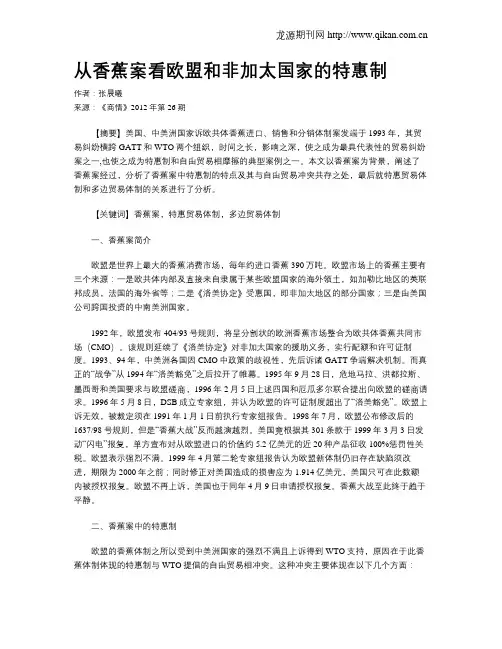
从香蕉案看欧盟和非加太国家的特惠制作者:张晨曦来源:《商情》2012年第26期【摘要】美国、中美洲国家诉欧共体香蕉进口、销售和分销体制案发端于1993年,其贸易纠纷横跨GATT和WTO两个组织,时间之长,影响之深,使之成为最具代表性的贸易纠纷案之一,也使之成为特惠制和自由贸易相摩擦的典型案例之一。
本文以香蕉案为背景,阐述了香蕉案经过,分析了香蕉案中特惠制的特点及其与自由贸易冲突共存之处,最后就特惠贸易体制和多边贸易体制的关系进行了分析。
【关键词】香蕉案,特惠贸易体制,多边贸易体制一、香蕉案简介欧盟是世界上最大的香蕉消费市场,每年约进口香蕉390万吨。
欧盟市场上的香蕉主要有三个来源:一是欧共体内部及直接来自隶属于某些欧盟国家的海外领土,如加勒比地区的英联邦成员,法国的海外省等;二是《洛美协定》受惠国,即非加太地区的部分国家;三是由美国公司跨国投资的中南美洲国家。
1992年,欧盟发布404/93号规则,将呈分割状的欧洲香蕉市场整合为欧共体香蕉共同市场(CMO)。
该规则延续了《洛美协定》对非加太国家的援助义务,实行配额和许可证制度。
1993、94年,中美洲各国因CMO中政策的歧视性,先后诉诸GATT争端解决机制。
而真正的“战争”从1994年“洛美豁免”之后拉开了帷幕。
1995年9月28日,危地马拉、洪都拉斯、墨西哥和美国要求与欧盟磋商,1996年2月5日上述四国和厄瓜多尔联合提出向欧盟的磋商请求。
1996年5月8日,DSB成立专家组,并认为欧盟的许可证制度超出了“洛美豁免”。
欧盟上诉无效,被裁定须在1991年1月1日前执行专家组报告。
1998年7月,欧盟公布修改后的1637/98号规则,但是“香蕉大战”反而越演越烈。
美国竟根据其301条款于1999年3月3日发动“闪电”报复,单方宣布对从欧盟进口的价值约5.2亿美元的近20种产品征收100%惩罚性关税。
欧盟表示强烈不满。
1999年4月第二轮专家组报告认为欧盟新体制仍旧存在缺陷须改进,期限为2000年之前;同时修正对美国造成的损害应为1.914亿美元,美国只可在此数额内被授权报复。
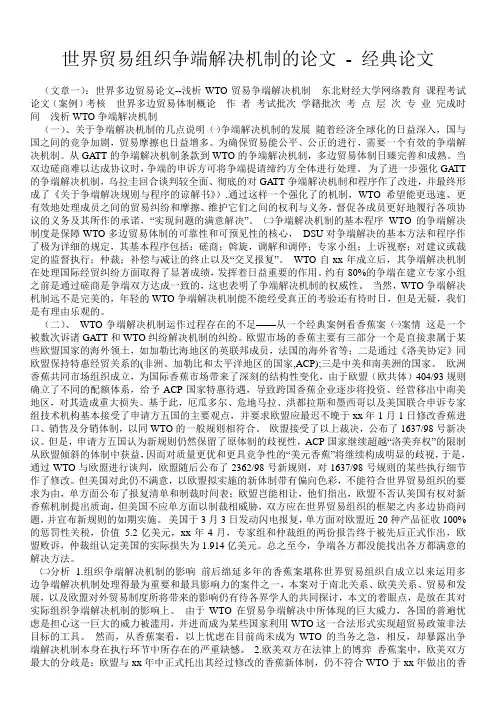
世界贸易组织争端解决机制的论文- 经典论文(文章一):世界多边贸易论文--浅析WTO贸易争端解决机制东北财经大学网络教育课程考试论文(案例)考核世界多边贸易体制概论作者考试批次学籍批次考点层次专业完成时间浅析WTO争端解决机制(一)、关于争端解决机制的几点说明㈠争端解决机制的发展随着经济全球化的日益深入,国与国之间的竞争加剧,贸易摩擦也日益增多。
为确保贸易能公平、公正的进行,需要一个有效的争端解决机制。
从GATT的争端解决机制条款到WTO的争端解决机制,多边贸易体制日臻完善和成熟。
当双边磋商难以达成协议时,争端的申诉方可将争端提请缔约方全体进行处理。
为了进一步强化GATT 的争端解决机制,乌拉圭回合谈判较全面、彻底的对GATT争端解决机制和程序作了改进,并最终形成了《关于争端解决规则与程序的谅解书》).通过这样一个强化了的机制,WTO希望能更迅速、更有效地处理成员之间的贸易纠纷和摩擦、维护它们之间的权利与义务,督促各成员更好地履行各项协议的义务及其所作的承诺,“实现问题的满意解决”。
㈡争端解决机制的基本程序WTO的争端解决制度是保障WTO多边贸易体制的可靠性和可预见性的核心,DSU对争端解决的基本方法和程序作了极为详细的规定,其基本程序包括:磋商;斡旋,调解和调停;专家小组;上诉视察;对建议或裁定的监督执行;仲裁;补偿与减让的终止以及“交叉报复”。
WTO自xx年成立后,其争端解决机制在处理国际经贸纠纷方面取得了显著成绩,发挥着日益重要的作用。
约有80%的争端在建立专家小组之前是通过磋商是争端双方达成一致的,这也表明了争端解决机制的权威性。
当然,WTO争端解决机制远不是完美的,年轻的WTO争端解决机制能不能经受真正的考验还有待时日,但是无疑,我们是有理由乐观的。
(二)、WTO争端解决机制运作过程存在的不足——从一个经典案例看香蕉案㈠案情这是一个被数次诉诸GATT和WTO纠纷解决机制的纠纷。
欧盟市场的香蕉主要有三部分一个是直接隶属于某些欧盟国家的海外领土,如加勒比海地区的英联邦成员,法国的海外省等;二是通过《洛美协定》同欧盟保持特惠经贸关系的(非洲、加勒比和太平洋地区的国家,ACP);三是中美和南美洲的国家。
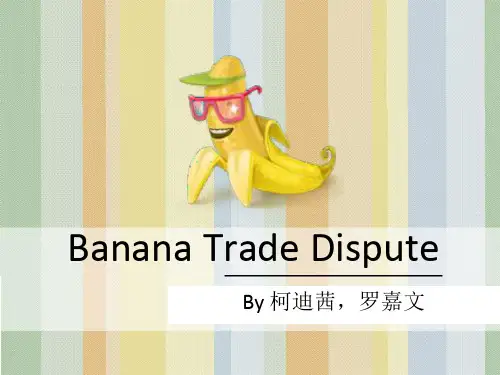
农业农村部办公厅关于2023年农产品质量安全监管执法典型案例的通报文章属性•【制定机关】农业农村部•【公布日期】2024.02.04•【文号】农办质〔2024〕2号•【施行日期】2024.02.04•【效力等级】部门工作文件•【时效性】现行有效•【主题分类】农产品质量安全正文农业农村部办公厅关于2023年农产品质量安全监管执法典型案例的通报农办质〔2024〕2号各省、自治区、直辖市及计划单列市农业农村(农牧)、畜牧兽医、渔业厅(局、委),新疆生产建设兵团农业农村局:2023年各级农业农村部门坚决贯彻习近平总书记“四个最严”重要指示精神,严格落实新修订施行的农产品质量安全法规定,深入推进豇豆农药残留突出问题攻坚治理,扎实开展食用农产品“治违禁控药残促提升”三年行动,加大监管执法力度,严厉打击禁限用药物违法使用行为,严格管控常规农兽药残留超标问题,积极查办农产品质量安全案件,有力震慑了违法犯罪行为。
经省级推荐和我部遴选,确定了12个具有较强指导性的典型案例,包括违法使用禁限用药物、常规药物残留超标和未按照规定开具、收取、保存承诺达标合格证三类,现予以通报。
地方各级农业农村部门要按照新修订的农产品质量安全法要求,对农产品质量安全违法违规行为始终保持高压严打态势,进一步加强监管执法,切实守好农产品质量安全底线。
附件:2023年农产品质量安全监管执法典型案例农业农村部办公厅2024年2月4日2023年农产品质量安全监管执法典型案例一、违法使用禁限用药物1.河南省内黄县农业农村局查处王某某和杨某某在豇豆种植中使用禁止在蔬菜上使用的农药氧乐果案2023年9月,河南省内黄县农业农村局对该县后河镇王某某和杨某某两位农户种植的豇豆开展监督抽查,在豇豆样品中检出禁止在蔬菜上使用的农药氧乐果。
2023年9月,内黄县农业农村局依法将案件移送公安机关查处。
2023年10月,内黄县公安局依法对当事人王某某和杨某某分别作出行政拘留6天的行政处罚决定。
美国和中美洲各国(厄瓜多尔、危地马拉、洪都拉斯、墨西哥)与欧共体香蕉进口、销售和分销体制案1993年2月,欧共体颁布了依据区内香蕉的不同来源确立不同配额体系的404/93号规则。
对此,美国和中美洲各国(厄瓜多尔、危地马拉、洪都拉斯、墨西哥)于1995年9月28日,以欧共体此举违背了WTO的一般最惠国待遇、国民待遇和非歧视性实施数量限制等原则为由,联合向WTO提出申诉,要求就欧共体香蕉进口、销售和分销体制与欧共体进行磋商。
在磋商未果的情况下,申诉方于1996年要求成立专家组审理此案。
WTO争端解决机构(DSB)最后支持了申诉方的请求,并建议欧共体在合理的时间内采取必要措施以履行其在WTO各有关协议下的义务。
为执行DSB报告,欧共体分别于1998年7月和10月公布了1637/98号和2362/98号规则,对原有规则进行了修改。
对此,申诉各方并不满意,认为新规则不符合DSB报告的要求。
欧盟认为,美国无权单方面作出欧共体是否已经执行裁决的判定并据此采取制裁措施。
厄瓜多尔则申请原专家组对欧共体是否执行做出评定。
原专家组针对厄瓜多尔的申请,做出欧共体并未完全执行的裁决。
案件评析:根据贸易争端解决机机制(DSU)第21条第1款的规定,DSB报告的执行义务成员方必须迅速履行DSB的各项建议或决定,以确保有效解决各项争端。
据此,WTO成员方负有迅速履行DSB报告的义务,但对于成员方的行为是否构成了对DSB报告的真正或完全履行这一问题则有可能在各方之间发生分歧,对此,DSU第21条第5款做出了明确规定。
本案涉及的另一个问题是报复的水平认定问题。
根据DSU的规定,因某一成员方违反WTO规则而受损的成员方有权在该违法成员方拒不执行DSB报告或双方未就补偿措施达成协议的情况下中止其对该违法成员方基于WTO协议的一定程度的关税减让或其他义务,以弥补其因为该成员方违法措施所造成的损失,这就是所谓的报复措施。
DSU要求报复的水平与其遭受的损失水平相一致。